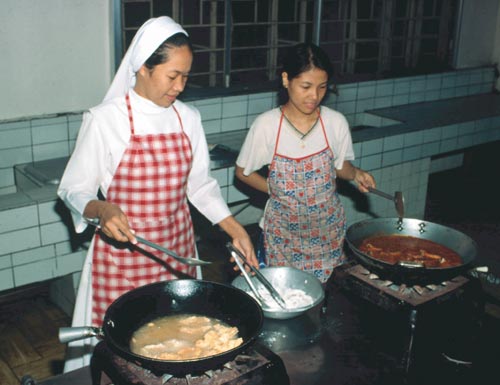Acts of Nutrition
By Aili Petersen
Testing nutritious rice varieties in a Philippine convent
Testing nutritious rice varieties in a Philippine convent

DOI: 10.1511/2000.35.0
You probably thought the Crusades ended sometime in the late 13th century. In fact, there is a new crusade under way, and 27 Roman Catholic sisters recently participated in the fight against malnutrition. Allowing scientists to move into their Philippine convent, the religious sisters, who range in age from 22 to 36 years old, provided evidence that experimental rice varieties could terminate iron-deficiency anemia in people whose primary diet is rice. Many of the sisters were mildly anemic prior to the study, but after substituting the new iron-rich rice for ordinary market rice, their blood iron rose significantly, sometimes reaching levels as much as two to three times the previously recorded baseline quantities. In some cases, this was sufficient to raise their iron levels from deficient to above normal.

International Rice Research Institute
Rice, a staple in the diets of millions of people in the world's poorest areas, typically lacks sufficient levels of iron and zinc. These deficits cause "about two billion people [to] suffer from iron-deficiency anemia, nearly one third of the world's population," notes the International Rice Research Institute (IRRI). Most of those affected are pregnant women and young children.
Plant breeders at IRRI began the studies that led to rice variety IR68144 with the hope of increasing rice productivity in regions with below-average temperatures and soil quality. Yet these attempts, performed using traditional breeding techniques rather than direct genetic modification, actually offered more than investigators were expecting. "Quite by chance, it was discovered that one of the varieties designed to tolerate low temperatures had also inherited a richness in iron and zinc from one of its parents," says Glenn B. Gregorio, an affiliate scientist and plant breeder at IRRI. IR68144 was not only nutrient-rich and hardy but, among its other extraordinary qualities, was also disease-resistant, high-yielding and flavorful.
IR68144 seemed too good to be true, and scientists had doubts about whether anyone would be able to benefit from the extra nutrients after the product had undergone processing, cooking and digestion. To find out, testing was done at Cornell University, first on laboratory rats and then on cultures of human colon cells. Later, IRRI collaborated with the Institute of Human Nutrition (part of the College of Human Ecology at the University of the Philippines at Los Baños) to supervise an experiment where the high-iron rice was fed to a family of six in the Philippines. After these studies yielded positive results, the investigators decided to run a larger human-consumption trial and turned to the sisters.
Chosen for a variety of reasons, the sisters were "ideal," according to Gregorio, who coordinated the research with the convent. "Because they are women at reproductive age," he explained, "they are prone to iron-deficiency anemia due to their physiological needs," such as blood loss during the menstrual cycle. Throughout the study, the sisters were willing to eat what they were served and to have their blood tested approximately once a month. During the six-month period, scientists weighed the sisters' food and drink at each meal and recorded their activities. The sisters' health improved significantly; overall, higher serum ferritin levels in blood were found, moving many of the sisters from the iron-deficient range to above average.
The sisters hoped their participation would benefit the poor, especially women and children, and thanks to their charity more nutritious rice may become available to malnourished peoples within a few years. First, however, another more fully controlled feeding trial involving 200 sisters will take place. Gregorio notes that "10 hectares of the high-iron rice and control rice for the next bioavailability study [to take place] early next year" have already been planted. Should this trial confirm the results of the previous one, IR68144 will undergo several additional tests, such as crossbreeding against pests and diseases, before being distributed-at no cost-to farmers in developing countries in as early as two or three years.
Crop scientists hope, by breeding or engineering grains with higher nutritional value, to offer options to people in rural or poor areas that lack the technology necessary for the post-harvest enrichment commonly used to add nutrients to rice in industrialized nations. IRRI, which developed IR68144 in collaboration with the International Food Policy Research Institute (IFPRI) with support from international-development agencies in Denmark, Australia and the U.S., plans to continue creating nutrient-rich rice varieties, including one with an even higher iron content. Meanwhile, the Institute for Plant Sciences at the Swiss Federal Institute of Technology has already developed a genetically engineered rice fortified with vitamin A. Similar developments are expected soon in other food staples such as wheat and maize. Amen.—Aili Petersen
Click "American Scientist" to access home page
American Scientist Comments and Discussion
To discuss our articles or comment on them, please share them and tag American Scientist on social media platforms. Here are links to our profiles on Twitter, Facebook, and LinkedIn.
If we re-share your post, we will moderate comments/discussion following our comments policy.